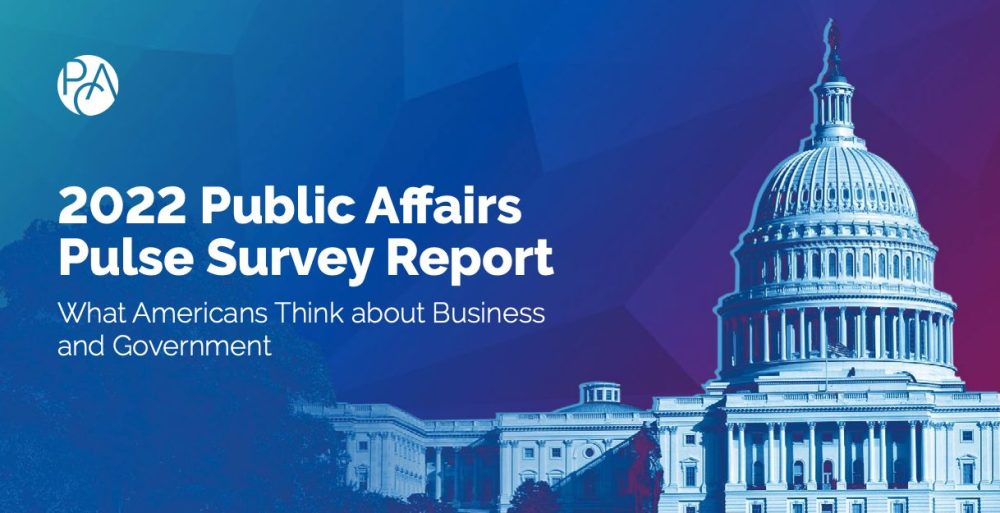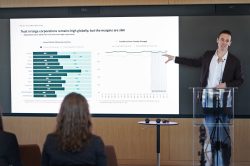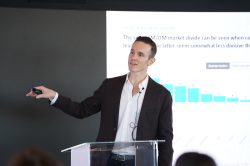
Purchase Intent as a Measure of PR Success
 This blog is provided by the IPR Measurement Commission. Earned media is often challenging to measure for impact – especially compared to other communication methods with more clear attribution, such as advertising.For decades, PR professionals have used various methods to show the relationship between consumer exposure to positive brand news and changes in behavior. Researchers have historically turned to perceived authenticity and organic appeal to defend PR investment, but quantifying these efforts is much more challenging, particularly relative to advertising.The Challenge of Showing PR ValueWhile some early studies weren’t able to demonstrate earned media’s credibility compared to advertising, more recent studies – such as O’Neil, Eisenmann and Holman’s 2019 qualitative research – clearly show that people find earned media more credible and authentic. That’s especially so when the journalist is independent, balanced, and credentialed.We’ve seen several different approaches and attempts to communicate the value of PR-driven news by mirroring advertising metrics, and sometimes multiplying these metrics. These efforts often prove unsuccessful, however, as they typically result in numbers and dollar values that don’t necessarily equate to actual impact. This only reiterates the challenge of showing the value of PR compared to advertising.As a result of this challenge, PR activities have focused on top-of-the-funnel metrics such as awareness, and marketing budgets have been highly skewed toward advertising. The result has been lower overall investment in PR: In 2020, ad agencies earned almost four times the revenue of PR agencies.New Study Shows PR Value Through Lower-Funnel ImpactA more recent quantitative study (p. 60) I conducted earlier this year challenges this financial distribution, illustrating that PR influences lower-funnel metrics not just as well as advertising, but even more effectively.The study shows that exposure to positive news spurred by PR activities has a greater influence on purchase intent than advertising – a finding that directly supports increased budgets for PR where brands could see a higher return. Based on a survey of nearly 50,000 responses, the study also shows that news exposure had a six-percentage point advantage over ad exposure – and that the combination of news and ads had a 14-percentage point lift over ads only.This confirms that PR exposure not only has a stronger impact on purchase intent than ad exposure alone, but that their impact can grow exponentially when combined. The study also found that positive news exposure results in higher lift across brand health measures and word of mouth, with PR’s influence on purchase intent two times greater than advertising.This same approach could be applied to specific brands or campaigns to show the value of PR work in relation to a behavior-predicting metric – purchase intent.Brand Lift Studies to Measure Purchase IntentBrand lift studies are an excellent method of measuring campaign effectiveness and purchase intent. These studies survey audiences exposed or engaged with a particular brand or campaign, comparing their perceptions to other groups that aren’t exposed. The goal is to show that those who are exposed have more awareness or a better perception of the brand.These surveys often include questions about past purchases and purchase intent to show that those exposed to the campaign or brand content are more likely to buy. Brand lift studies can also be used to show an increase in purchase intent over time with exposed audiences. Surveys are a tried-and-true method of uncovering customer perceptions, including purchase intent, that can show the value of PR efforts.Social Conversation Analysis for Purchase IntentSocial conversation analysis is another way of measuring purchase intent around initiatives such as influencer campaigns. This method involves looking at engagement on all influencer posts, then diving deeper to analyze the content while scanning for words or topics that indicate intent. Examples of this kind of language include: “I have to have it—I’m going to buy this product right now!
This blog is provided by the IPR Measurement Commission. Earned media is often challenging to measure for impact – especially compared to other communication methods with more clear attribution, such as advertising.For decades, PR professionals have used various methods to show the relationship between consumer exposure to positive brand news and changes in behavior. Researchers have historically turned to perceived authenticity and organic appeal to defend PR investment, but quantifying these efforts is much more challenging, particularly relative to advertising.The Challenge of Showing PR ValueWhile some early studies weren’t able to demonstrate earned media’s credibility compared to advertising, more recent studies – such as O’Neil, Eisenmann and Holman’s 2019 qualitative research – clearly show that people find earned media more credible and authentic. That’s especially so when the journalist is independent, balanced, and credentialed.We’ve seen several different approaches and attempts to communicate the value of PR-driven news by mirroring advertising metrics, and sometimes multiplying these metrics. These efforts often prove unsuccessful, however, as they typically result in numbers and dollar values that don’t necessarily equate to actual impact. This only reiterates the challenge of showing the value of PR compared to advertising.As a result of this challenge, PR activities have focused on top-of-the-funnel metrics such as awareness, and marketing budgets have been highly skewed toward advertising. The result has been lower overall investment in PR: In 2020, ad agencies earned almost four times the revenue of PR agencies.New Study Shows PR Value Through Lower-Funnel ImpactA more recent quantitative study (p. 60) I conducted earlier this year challenges this financial distribution, illustrating that PR influences lower-funnel metrics not just as well as advertising, but even more effectively.The study shows that exposure to positive news spurred by PR activities has a greater influence on purchase intent than advertising – a finding that directly supports increased budgets for PR where brands could see a higher return. Based on a survey of nearly 50,000 responses, the study also shows that news exposure had a six-percentage point advantage over ad exposure – and that the combination of news and ads had a 14-percentage point lift over ads only.This confirms that PR exposure not only has a stronger impact on purchase intent than ad exposure alone, but that their impact can grow exponentially when combined. The study also found that positive news exposure results in higher lift across brand health measures and word of mouth, with PR’s influence on purchase intent two times greater than advertising.This same approach could be applied to specific brands or campaigns to show the value of PR work in relation to a behavior-predicting metric – purchase intent.Brand Lift Studies to Measure Purchase IntentBrand lift studies are an excellent method of measuring campaign effectiveness and purchase intent. These studies survey audiences exposed or engaged with a particular brand or campaign, comparing their perceptions to other groups that aren’t exposed. The goal is to show that those who are exposed have more awareness or a better perception of the brand.These surveys often include questions about past purchases and purchase intent to show that those exposed to the campaign or brand content are more likely to buy. Brand lift studies can also be used to show an increase in purchase intent over time with exposed audiences. Surveys are a tried-and-true method of uncovering customer perceptions, including purchase intent, that can show the value of PR efforts.Social Conversation Analysis for Purchase IntentSocial conversation analysis is another way of measuring purchase intent around initiatives such as influencer campaigns. This method involves looking at engagement on all influencer posts, then diving deeper to analyze the content while scanning for words or topics that indicate intent. Examples of this kind of language include: “I have to have it—I’m going to buy this product right now! 

 ”, “I just bought one for me and for each of my sisters!
”, “I just bought one for me and for each of my sisters!  ”, “Can’t wait to get my hands on this new product!
”, “Can’t wait to get my hands on this new product!  ”, and “I’m definitely going to buy this!
”, and “I’m definitely going to buy this! 
 ”.This approach can help identify which types of posts or influencers generate not only the highest engagement numbers, but also the most purchase intent.Just as we’ve shown the value of PR over advertising on lower-funnel metrics, we can use purchase intent to show the value of PR campaigns and ongoing coverage through brand lift surveys and social media analysis.Purchase intent can be deployed as a powerful metric to show value among other attribution approaches that move us closer to effectively measuring PR success – making a compelling argument for increased investment in PR by large organizations.
”.This approach can help identify which types of posts or influencers generate not only the highest engagement numbers, but also the most purchase intent.Just as we’ve shown the value of PR over advertising on lower-funnel metrics, we can use purchase intent to show the value of PR campaigns and ongoing coverage through brand lift surveys and social media analysis.Purchase intent can be deployed as a powerful metric to show value among other attribution approaches that move us closer to effectively measuring PR success – making a compelling argument for increased investment in PR by large organizations.
 Angela Dwyer is Head of Insights at Fullintel, IPR Measurement Commission member and IPRRC board member. She is an award-winning, media measurement expert who helps brand improve business results through data-driven, actionable insights.
...
Angela Dwyer is Head of Insights at Fullintel, IPR Measurement Commission member and IPRRC board member. She is an award-winning, media measurement expert who helps brand improve business results through data-driven, actionable insights.
...



 This blog is provided by the IPR Measurement Commission in celebration of its 25th Anniversary and AMEC’s Measurement Month.It’s hard to imagine 2004. I joined The Goodyear Tire & Rubber Company a year earlier and attended the “Summit on Measurement” in New Hampshire for the first time. I met Katie Paine, Dr. Don Wright, and countless other people giving their time and effort to the Institute for PR to bridge the gap between the public relations profession and its research base.The days passed in a blur as I learned about how PR could be measured. At the time, I believed what people had told me: PR can’t be measured. It’s an art. It’s never going to be taken seriously like marketing is. It’s a “nice to have.”Those tales were especially applied to employee communication. Employee communication is “a warm fuzzy for employees,” not a serious, strategic discipline (as a General Counsel once told me), and certainly not as important as media relations. The Summit caused me not just to revisit those tropes, but to believe exactly the opposite.I cornered Dr. Don Wright about how the Summit had really inspired me and asked how I could get involved with the organization. By December 15, I was elected by the IPR Measurement Commission to join its ranks. In short order, I was rubbing elbows with people whose work I had read.At first, I was intimidated. I was relatively new in public relations and had just started at Goodyear following years at KeyBank and a small agency. Measurement was so new to me. How could I possibly contribute to the organization? The Commission embraced me and nurtured my intellect. I launched a research project at Goodyear and published the results. I did small projects, like looking into how companies were using social media and published those (both of these studies were in partnership with Dr. Julie O’Neil, current chair of the IPR Measurement Commission!) I got bit by the research and measurement bug big time.I moved on to the regional powerhouse National City Bank and continued researching, measuring, and publishing. This was during the 2008 financial crisis, and my measurement plans expanded to examining the impact of unpaid media on direct mail performance, quantifying the tone and volume of negative and positive PR on the perception of risk, and advising the CCO on projects to counter negative coverage.I became a consultant, with the measurement at the heart of strategy, and now I’m a teaching professor at BGSU.All of that is only possible because of that conversation with Don Wright some 18 years ago. The IPR Measurement Commission has meant so much to me personally and professionally. Gee, it only meant the discovery of my life’s work!Congratulations, Measurement Commission!
This blog is provided by the IPR Measurement Commission in celebration of its 25th Anniversary and AMEC’s Measurement Month.It’s hard to imagine 2004. I joined The Goodyear Tire & Rubber Company a year earlier and attended the “Summit on Measurement” in New Hampshire for the first time. I met Katie Paine, Dr. Don Wright, and countless other people giving their time and effort to the Institute for PR to bridge the gap between the public relations profession and its research base.The days passed in a blur as I learned about how PR could be measured. At the time, I believed what people had told me: PR can’t be measured. It’s an art. It’s never going to be taken seriously like marketing is. It’s a “nice to have.”Those tales were especially applied to employee communication. Employee communication is “a warm fuzzy for employees,” not a serious, strategic discipline (as a General Counsel once told me), and certainly not as important as media relations. The Summit caused me not just to revisit those tropes, but to believe exactly the opposite.I cornered Dr. Don Wright about how the Summit had really inspired me and asked how I could get involved with the organization. By December 15, I was elected by the IPR Measurement Commission to join its ranks. In short order, I was rubbing elbows with people whose work I had read.At first, I was intimidated. I was relatively new in public relations and had just started at Goodyear following years at KeyBank and a small agency. Measurement was so new to me. How could I possibly contribute to the organization? The Commission embraced me and nurtured my intellect. I launched a research project at Goodyear and published the results. I did small projects, like looking into how companies were using social media and published those (both of these studies were in partnership with Dr. Julie O’Neil, current chair of the IPR Measurement Commission!) I got bit by the research and measurement bug big time.I moved on to the regional powerhouse National City Bank and continued researching, measuring, and publishing. This was during the 2008 financial crisis, and my measurement plans expanded to examining the impact of unpaid media on direct mail performance, quantifying the tone and volume of negative and positive PR on the perception of risk, and advising the CCO on projects to counter negative coverage.I became a consultant, with the measurement at the heart of strategy, and now I’m a teaching professor at BGSU.All of that is only possible because of that conversation with Don Wright some 18 years ago. The IPR Measurement Commission has meant so much to me personally and professionally. Gee, it only meant the discovery of my life’s work!Congratulations, Measurement Commission!
 Sean D. Willliams is a member of the IPR Measurement Commission and an Assistant Teaching Professor at Bowling Green State University.
...
Sean D. Willliams is a member of the IPR Measurement Commission and an Assistant Teaching Professor at Bowling Green State University.
... 



 Corporate involvement in social issues such as racial justice, voting access and climate change is on the rise, but so is demand for corporate leadership on these issues.More than 60% of Americans would like to see major companies advocate to protect the environment; provide food security; end discrimination based on gender, race, sexual orientation and gender identity; and provide access to quality education. And more than 50% would like to see firms lobby for human rights and affordable housing.These data come from the 2022 Public Affairs Pulse Survey, produced by the Public Affairs Council and Morning Consult. The annual poll of 2,210 adults was conducted Sept. 1-2, 2022.Some social issues are contentious, which can create controversy (and political opposition) when companies weigh in. While 68% of Americans support corporate efforts to help the environment and alleviate hunger, only 42% want companies involved in the debate over Deferred Action for Childhood Arrivals (DACA), a federal program designed to provide a pathway to citizenship for people brought to the U.S. illegally as children. A near equal percentage (41%) would like to see companies “not too involved” or “not involved at all.”Controversy also exists with the abortion issue, which heated up significantly when the U.S. Supreme Court overturned Roe v. Wade earlier this year. Once again, the country was split, with 41% wanting businesses involved in advocating for legal abortions and 42% preferring that companies stay on the sidelines. These splits were often along party lines. While 58% of Democrats supported business involvement in DACA and 59% wanted firms to speak out in favor of legal access to abortions, Republican percentages in favor of these two issues were 25% and 23%, respectively.Political Alliances Are ShiftingIntense partisanship has not only created distance between the two major parties, it also is causing major alliances to show signs of shifting. Many large corporations are realizing that on certain issues they have more in common with Democrats.Last year the Pulse Survey noted the growing divergence between the views of many Republicans and the interests of major companies. The GOP used to be considered a reliable supporter of business at all levels of government. In many regions of the country, this is still the case. But, while the business community and the Democratic Party still have sharp differences on regulatory and tax issues, they are finding agreement on other matters.
Corporate involvement in social issues such as racial justice, voting access and climate change is on the rise, but so is demand for corporate leadership on these issues.More than 60% of Americans would like to see major companies advocate to protect the environment; provide food security; end discrimination based on gender, race, sexual orientation and gender identity; and provide access to quality education. And more than 50% would like to see firms lobby for human rights and affordable housing.These data come from the 2022 Public Affairs Pulse Survey, produced by the Public Affairs Council and Morning Consult. The annual poll of 2,210 adults was conducted Sept. 1-2, 2022.Some social issues are contentious, which can create controversy (and political opposition) when companies weigh in. While 68% of Americans support corporate efforts to help the environment and alleviate hunger, only 42% want companies involved in the debate over Deferred Action for Childhood Arrivals (DACA), a federal program designed to provide a pathway to citizenship for people brought to the U.S. illegally as children. A near equal percentage (41%) would like to see companies “not too involved” or “not involved at all.”Controversy also exists with the abortion issue, which heated up significantly when the U.S. Supreme Court overturned Roe v. Wade earlier this year. Once again, the country was split, with 41% wanting businesses involved in advocating for legal abortions and 42% preferring that companies stay on the sidelines. These splits were often along party lines. While 58% of Democrats supported business involvement in DACA and 59% wanted firms to speak out in favor of legal access to abortions, Republican percentages in favor of these two issues were 25% and 23%, respectively.Political Alliances Are ShiftingIntense partisanship has not only created distance between the two major parties, it also is causing major alliances to show signs of shifting. Many large corporations are realizing that on certain issues they have more in common with Democrats.Last year the Pulse Survey noted the growing divergence between the views of many Republicans and the interests of major companies. The GOP used to be considered a reliable supporter of business at all levels of government. In many regions of the country, this is still the case. But, while the business community and the Democratic Party still have sharp differences on regulatory and tax issues, they are finding agreement on other matters.
 Support for corporate involvement on major social issues is much stronger among Democrats than among Republicans. On expanding voting rights, 65% of Democrats wanted companies involved and only 29% of Republicans agreed. On fighting race discrimination, 75% of Democrats were in favor of corporate engagement while only 56% of Republicans were in favor. On ending gender discrimination, 78% of Democrats welcomed the help of businesses while 55% of Republicans agreed. On opposing discrimination by sexual orientation, 74% of Democrats were supportive and only 52% of Republicans wanted companies involved.Even when it came to support for the environment, 77% of Democrats supported business engagement and only 61% of Republicans agreed.This year’s Pulse Survey also showed “green shoots” of Democratic support for business public affairs practices. Traditionally, those on the political left and center have expressed more distrust of such activities that have conservatives.— While 80% of Republicans considered extensive lobbying in Washington, D.C., to be a major problem in the U.S. political system, only half of Democrats (49%) and Independents (51%) agreed.— While 45% of Republicans believed political action committees (PACs) were a major problem, only 36% of Democrats and 35% of Independents concurred.And yet, when it came to basic trust in major companies to behave ethically, 57% of Republicans had some or a lot of trust in major companies while only 52% of Democrats had such trust. These numbers were similar to those in past polls and indicate persistent doubts about corporate behavior and motivation.Different Age Groups Support Different Social IssuesTo make matters more complicated, the poll found that different age groups were more supportive of different social issues. A majority (51%) of adults under 35 would like companies to be involved in the abortion issue, while only 41% of those age 35-44, 34% of those age 45-64 and 37% of those 65+ agreed. Age-group agreement with corporate support for DACA followed a similar pattern.In contrast, support for corporate efforts to end gender discrimination flowed in the opposite direction. Seventy-six percent (76%) of adults 65 and older would like companies to be involved in this issue. They were joined by 69% of those age 35-44 and 67% of those age 45-64. But only 60% of those age 18-34 agreed.With all this conflating data, perhaps 2022 will go down in history as “The Year of Political Mixed Messages.” But until corporations can convince the public and political leaders their commitments to social justice and other causes are genuine, long-lasting and helpful to society, they will be viewed with ire by many Republicans and with skepticism by some Democrats.
Support for corporate involvement on major social issues is much stronger among Democrats than among Republicans. On expanding voting rights, 65% of Democrats wanted companies involved and only 29% of Republicans agreed. On fighting race discrimination, 75% of Democrats were in favor of corporate engagement while only 56% of Republicans were in favor. On ending gender discrimination, 78% of Democrats welcomed the help of businesses while 55% of Republicans agreed. On opposing discrimination by sexual orientation, 74% of Democrats were supportive and only 52% of Republicans wanted companies involved.Even when it came to support for the environment, 77% of Democrats supported business engagement and only 61% of Republicans agreed.This year’s Pulse Survey also showed “green shoots” of Democratic support for business public affairs practices. Traditionally, those on the political left and center have expressed more distrust of such activities that have conservatives.— While 80% of Republicans considered extensive lobbying in Washington, D.C., to be a major problem in the U.S. political system, only half of Democrats (49%) and Independents (51%) agreed.— While 45% of Republicans believed political action committees (PACs) were a major problem, only 36% of Democrats and 35% of Independents concurred.And yet, when it came to basic trust in major companies to behave ethically, 57% of Republicans had some or a lot of trust in major companies while only 52% of Democrats had such trust. These numbers were similar to those in past polls and indicate persistent doubts about corporate behavior and motivation.Different Age Groups Support Different Social IssuesTo make matters more complicated, the poll found that different age groups were more supportive of different social issues. A majority (51%) of adults under 35 would like companies to be involved in the abortion issue, while only 41% of those age 35-44, 34% of those age 45-64 and 37% of those 65+ agreed. Age-group agreement with corporate support for DACA followed a similar pattern.In contrast, support for corporate efforts to end gender discrimination flowed in the opposite direction. Seventy-six percent (76%) of adults 65 and older would like companies to be involved in this issue. They were joined by 69% of those age 35-44 and 67% of those age 45-64. But only 60% of those age 18-34 agreed.With all this conflating data, perhaps 2022 will go down in history as “The Year of Political Mixed Messages.” But until corporations can convince the public and political leaders their commitments to social justice and other causes are genuine, long-lasting and helpful to society, they will be viewed with ire by many Republicans and with skepticism by some Democrats.
 Doug Pinkham is president of the Public Affairs Council, the leading international association for public affairs professionals. Since joining the Council in 1997, he has expanded research programs, been quoted widely in major media, and has been a frequent speaker on public affairs issues, political risk, reputation management and related topics. You can reach him at dpinkham@pac.org.
...
Doug Pinkham is president of the Public Affairs Council, the leading international association for public affairs professionals. Since joining the Council in 1997, he has expanded research programs, been quoted widely in major media, and has been a frequent speaker on public affairs issues, political risk, reputation management and related topics. You can reach him at dpinkham@pac.org.
... 

































 ...
... 